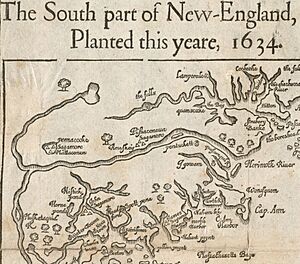Naumkeag people facts for kids
The Naumkeag were a group of Native American people. They spoke an Eastern Algonquian language. They lived in what is now northeastern Massachusetts. Around the time English settlers arrived, their land stretched from the Charles River to the Merrimack River.
The word "Naumkeag" also describes a Native American settlement. This settlement was located in today's Salem, Massachusetts. The name means "fishing place." It comes from their words for "fish" (namaas), "place" (ki), and "at" (age). Some also say it means "eel-land." This settlement was part of a larger group of connected villages. These villages were led by a chief, or sachem, named Nanepashemet. His wife, the Squaw Sachem, also led the people. European records sometimes called these people by different names. These included Pawtucket, Penticut, Mystic, or Wamesit.
Contents
Naumkeag Lands
The Naumkeag settlement was in present-day Salem. But the Naumkeag people controlled a much larger area. Many towns in Massachusetts received land deeds from Naumkeag leaders. Their territory went from the Charles River north to the Mystic River. It followed the coast up to Peabody. Then it went inland to the southern edge of the Merrimack River.
In 1639, the Squaw Sachem sold large areas of land. These lands went to the new English towns of Newtowne (now Cambridge) and Charlestown. This huge area included many modern-day cities and towns. Some of these are Cambridge, Newton, Lexington, Arlington, Malden, and Medford.
Later, in the 1680s, James Quonopohit and his relatives received payments. These payments were for land deeds from several towns. These towns included Marblehead (1684), Lynn, Saugus, and Salem (1687).
Naumkeag History
Early Times
People have lived in North America for at least 15,000 years. But a huge ice sheet covered much of Massachusetts. This ice sheet melted about 11,700 years ago. After that, people could live in the Naumkeag area. Very old human remains have been found nearby. They date back over 10,000 years.
The earliest written records about the Naumkeag people come from Europeans. These records are from the early 1600s. There are also some writings from Native Americans from the late 1600s.
Nanepashemet's Leadership
In 1614, an English explorer named John Smith explored New England. He wrote about "Naemkeck" as one of the "countries" along the coast. He said they were allied with groups to the north. At this time, the Naumkeag were led by Nanepashemet.
When many English Puritans came to New England in the early 1600s, the Naumkeag population was already much smaller. This was due to diseases and wars. From 1615, they fought a war with the Mi'kmaq people. Then, from 1616 to 1619, a terrible European disease spread. It greatly reduced the Native American populations along the coast. The Naumkeag people were hit very hard. The Mi'kmaq took advantage of this weakness. They killed many more Naumkeag, including their leader, Nanepashemet, in 1619.
The Squaw Sachem
In 1621, English colonists from Plymouth explored the area. They found the Naumkeag settlement where Nanepashemet had lived. They saw forts from the war and Nanepashemet's burial place. An explorer named Edward Winslow wrote that the area was controlled by a "squaw sachem." This was Nanepashemet's widow.
Nanepashemet's widow, known as the "Squaw Sachem," continued to lead the tribe. She ruled the region with her three sons. Their names were Wonohaquaham (Sagamore John), Montowampate (Sagamore James), and Wenepoykin (Sagamore George). A map from 1634 shows Sagamore John in present-day Medford. It shows Sagamore James in present-day Lynn. By 1629, Wenepoykin (Sagamore George) was the leader of the Naumkeag settlement in Salem. He might have had help from an older family member until he was old enough.
In 1633, another terrible disease, likely smallpox, spread. It nearly wiped out the tribe. This sickness killed both Montowampate and Wonohaquaham. This left the Squaw Sachem and Wenepoykin in charge. They controlled the land from modern-day Chelsea to Lowell to Salem.
Wenepoykin's Challenges
Wenepoykin survived the smallpox, but it left him disfigured. He became known as "George No Nose." When the Squaw Sachem died around 1650, Wenepoykin became the sole leader. He tried to claim his family's lands through the English legal system. But he was mostly unsuccessful. Over the next 20 years, the Naumkeag group became even smaller. The English government tried to move Native Americans into special "Praying Towns." Some of Wenepoykin's family members moved to these towns.
In 1675, Wenepoykin and some Naumkeag joined Metacomet in King Philip's War. This war changed everything for Native Americans in New England. Wenepoykin was captured in 1676. He was sold into slavery in Barbados. At the same time, over 1,000 Native Americans who were not fighting were held on Deer Island. Only 167 of them survived.
After 8 years of slavery, Wenepoykin returned to Massachusetts in 1684. This happened with help from John Eliot. Wenepoykin joined some family members in the Natick Praying Town. But he died later that year. He left his lands to a relative on his mother's side, James Quonopohit. By this time, English settlers lived on most of the Naumkeag's traditional land.
James Quonopohit
James Quonopohit was a relative of Wenepoykin. He lived in the Natick praying town. Wenepoykin gave him the rights to the Naumkeag lands in 1684. By this time, many more Europeans lived in Naumkeag territory than Naumkeag people. Many Naumkeag had moved to praying towns. Others had been killed in King Philip's War. Some fled north to join the Wabenaki Confederacy. Others were sold into slavery.
However, in 1684, the English king took back the charter for the Massachusetts Bay Colony. This made it hard for many English settlements to prove they owned their land. This gave Quonopohit and his family a chance. They asked for payment for their traditional lands. They showed their claims to ownership. They were eventually paid for deeds to several towns. These included Marblehead (1684), Lynn, Saugus, and Salem (1687).



